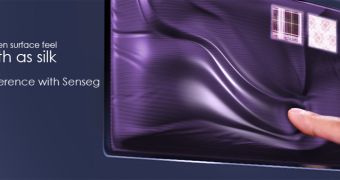Touchscreen technologies have come a long way, but there doesn't seem to be a limit to how much farther they can evolve, not with things like Senseg's new invention.
Going straight to the point, Senseg created a new type of touch technology that uses electrostatic fields to produce the sort of tactile sensation one would get when interacting with a real sample of whatever the display shows at the time.
This effect is known as Columb's force and matches whatever images are being displayed to an appropriate tactile response (friction, as it is otherwise known).
Thus, if the displays is showing, say, gravel, one will experience the sensation that their fingers really are passing through gravel.
Similarly, virtual silk feels silky smooth, rocks feel either rough or fine, depending on what sort of surface the display projects, etc.
All this is possible on the same, flat display that all of today's tablets and smartphones possess.
Nonetheless, that doesn't mean that implementing Columb's force on such electronics is as easy as updating the software.
If third parties decide they want the technology on their inventions, they will first have to license it, and then the electronic module that created the electrostatic charge.
Also, the special Senseg software needs to be integrated into the operating system, or the effects won't show up in applications.
Gaming is one area where tactile feedback of this nature could prove especially enriching to the overall experience.
This could also be exactly the sort of solution touch technology could use to become useful to blind people.
Certainly, there is still hope that a time will come when medicine has advanced to the point where blindness of any type can be cured, but that is still a far-off dream, until whose fulfillment the Senseg touchscreen could be just what people with sight impairment disabilities need.

 14 DAY TRIAL //
14 DAY TRIAL //